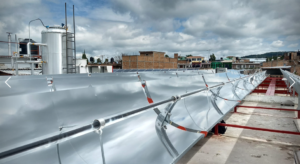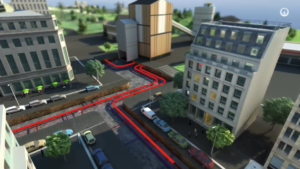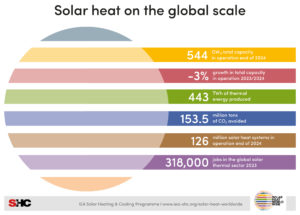Pilot projects show promising results for ultra-low-temperature district heating
May 17, 2023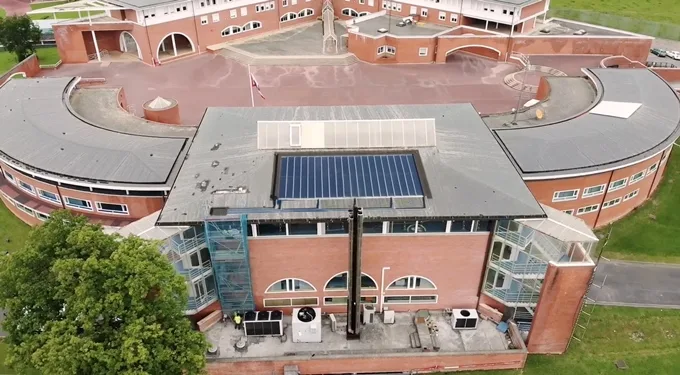
??????????
District heating systems have long been a key component of urban energy infrastructure, but they also come with significant heat losses and energy inefficiencies. Three pilot projects across Europe have been testing a new approach: ultra-low-temperature district heating – with promising results. By reducing heat losses and incorporating renewable energy sources such as solar thermal, ultra-low-temperature district heating has the potential to redefine the future district heating market. The pilot projects include building-integrated solar thermal devices (see photo from the spanish demonstrator) and special heat pump solutions.
Photo: Inaventa Solar
Reducing heat losses in district heating systems is one of the main challenges for achieving more sustainable and efficient district heating grids. In this context, the RELaTED, (Renewable Low Temperature District) project (2017 to 2022), aimed to develop innovative solutions to reduce energy consumption in buildings and promote sustainable energy. The pilot projects within RELaTED show that a mix of measures will usually be necessary to reduce operating temperatures in existing district heating networks.
Spain: Upgrade of 30-year-old district heating grid
Iurreta in the Basque Country is home to the emergency, rescue and fast intervention groups of the regional police. The campus is composed of a total of 14 multi-storey buildings. A 30 year old district heating system with a 650 kW boiler supplies space heating and hot water to the complex and is operated at 80/60 ºC. In the context of the RELaTED project, several measures have been realised to upgrade the district heating grid for a new era:
- The heat-supply systems inside the buildings have been converted to lower temperatures, so that the heat network can be adapted to around 40 to 45 °C.
- Three heat pumps have been installed in the two buildings where higher temperatures of around 50 to 55 °C are required.
- Building-integrated solar collector fields have been installed and heat pumps have been added to buildings with cooling needs.
- Control strategies have been adapted to ensure maximum utilisation of the façade-integrated solar thermal systems and the heat pump capacity. The control strategy is that solar heat is first used decentralised in the building for preheating the cold water. Surplus solar heat is then delivered to the ultra-low temperature district heating grid.
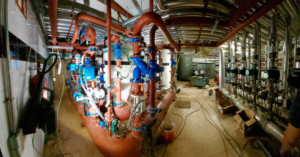
Demonstrator in Lurreta, Spain: New low-temperature system (left) ready to be connected to the existing system (right). Photo: RELaTED
Denmark: two identical laboratory buildings
This demonstration project in Denmark consists of two experimental buildings called energy flex houses located in Tåstrup, right outside Copenhagen. The two houses are identical in terms of building size and are connected to a small heat grid with ultra-low temperatures. One of the houses is designed as a residence for a family. It has been set up as a test arena for energy efficiency measures, control systems and user interfaces. The other house is a test laboratory to develop and evaluate new technologies.
Externally, the latter building appears to be a finished house, but on the inside, all the installations are exposed to the researchers and visitors alike. “The purpose of this pilot project was to test the new technologies in a highly interlinked way under realistic framework conditions considering changing energy pricing and the dynamics within a building”, explained Dr Roberto Garay Martinez, Project Coordinator of RELaTED.
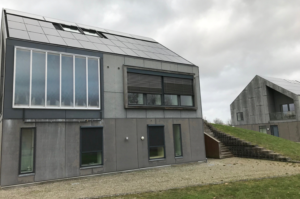
Two detached houses in Denmark connected to a district heating grid. The left-hand house is a laboratory for new technologies and includes façade-integrated solar collectors from the Norwegian company Inaventa Solar, whereas the right-hand house is occupied by a family. Photo: RELaTED
Estonia: lowering temperatures in a selected part of the network and using waste heat
The district heating system in Tartu, Estonia, is privately owned and operated by the utility company Gren. Around 500 GWh are delivered to more than 1,500 consumers in the city annually. 94 % of this energy is obtained from biomass and peat. The main consumers are multi-family buildings (49%), industrial and commercial buildings (33%) and individual households (18%), with 40-60 new grid connections per year.
Within the RELaTED project, Gren implemented several measures on its path towards more efficient operation. The utility company lowered the temperature of one part of the district heating grid with 54 consumers by 10 to 15 °C by the installation of a mixing chamber. Temperature reduction to 55 °C achieved thermal savings in the range of 400 MWh/year. In relative terms the initial heat losses of 17.8 % in 2019 dropped to 14.5 % in 2021. The RELaTED team provided an automated analysis of the measured data from the 54 substations on an hourly basis over two years.
Glen has also begun using excess heat from cooling applications with a total volume of 2.5 GWh in the first year of operation. Furthermore, the company has started using heat recovered from the cooling system of the combined heat and power plant with a potential of 10 GWh per year.
Garay Martinez confirmed that after two years of test operation the low-temperature grid approach could now being extended across the complete heat network in Tartu.
Websites of organisations mentioned in this news article:
RELaTED: http://www.relatedproject.eu/
Inaventa Solar: https://inaventasolar.com/en
Alejandro Diego Rosell is a freelance journalist and consultant specialised in renewable energies and based in Madrid, Spain.
